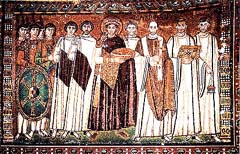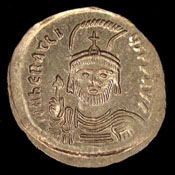HISTORY OF
THE EASTERN ROMAN EMPIRE - EARLY BYZANTINE PERIOD
The reforms associated with emperors Diocletian (A.D. 284-305) and Constantine
(306-337) should be seen as attempts to deal with the problems the empire
had to cope with in the 3rd century. They formed the basic organization
of society in the early Byzantine period and are notable as an important
attempt to regulate the life of a state through legislative fiat. The reforms
were inaugurated piece by piece at various times in response to the continuing
crisis and many of the details are uncertain, but they are probably best
understood together.
The reign of Diocletian put and end to the political chaos which had
plagued the empire. His administrative reforms were really important for
the empire. He subdivided the old provinces into new provinces, creating
two official states of the empire, the Eastern and Western. He divided
the empire into four administrative spheres using the system of Tetrarchy
(One Augustus and one Caesar in each part). His aim was to solve the civil
problems of its state. An elaborate civil hierarchy was created alongside
a military chain of command (praefectus praetorio, vicarius, praeses).
At the top of the military hierarchy was magister militum and below him
comes and dux. The officials of the court were magister officiorum, comes
sacrarum largitionum, comes rei privatae, praepositus sacri cubiculi. His
reforms were expanded in the military and economic life. Diocletian and
Constantine supported their political and military positions by reference
to religious ideals. The title of Diocletian was “Dominus et Deus” and
he introduced several oriental habits in his court. Constantinus established
Christianity as a legal religion of the empire (313) and stopped the measures
of Diocletian.
In 324 the decision
of Constatninus to transfer the capital of the empire from Rome to Constantinople
was based on the needs of his time. Constatninople was situated between
the eastern and northern Roman frontiers. It was an important center of
trade, located as it was on major north-south and east-west trade routes
and it was located on a peninsula on the European side of the Bosphoros.
The dedication of the city took place in 330 and Constantinus laid out
the general plan of the city and ordered the construction to take place
remarkably quickly, within about five years. The city was patterned after
Rome and its official title was "New Rome;" there were seven churches,
and a great palace, which later became the central part of the Great Palace.
The new capital of the empire had been established.
Constantine died in 337 and was succeeded by his three sons.
Constantine II and Constans shared rule in the West until Constantine's
death in 340. Constantius II was the strongest of the sons of Constantine
and he ruled the East until his death in 361. The division of the empire
among the sons of Constantine showed that the principle of divided rule,
established under Tetrarachy, could work. The next emperor was Julian (360-363)
who was raised as a Christian, but he decided to return to the religion
of his ancestors and he attempted a revival of paganism. Julian was succeeded
by Jovian (363-64), who was a Christian. After the death of Jovian, the
empire was divided between the two brothers Valens (364-78) and Valentinian
I (364-75). In 378 the empire experienced one of the worst defeats, at
the Battle of Adrianople, by the Visigoths, Germanic allies, who had been
settled within the empire.
After the disaster
of Adrianople, Gratian selected Theodosius the Great (379-395) as emperor
in the East. He was orthodox and at the Council of Constantinople in 381
he virtually put an end to Arianism, a doctrine which had dominated the
East for the past fifty years. Theodosius moved ardently against both pagans
and heretics and most would date the establishment of Christianity as the
state religion to his reign. After the death of Gratian, Theodosius became
involved in the West, and by the time of his death he ruled the whole of
an undivided empire.
During the fifth century,
an era characterized by the barbaric invasions, several emperors reigned:
Arcadius, son of Theodosius I (395-408). Theodosius II, son of Arcadius;
ruled jointly with his sister Pulcheria and his wife Athenais/Eudokia (408-50).
Marcian, husband of Pulcheria, ruled from 450 to 457. Leo I (457-74), came
to the throne as the candidate of the Germans under Aspar the Alan. Zeno
(474-91) came to the throne after the death of the young Leo II. Anastasius
(491-519) supported monophysitism and reformed the economy, adding considerably
to the treasury. Justin I (519-27) became commander of the palace guard
and forced himself on the empire.

The reign of Justinian I is widely accepted as the golden age of the
Early Byzantine Era. He succeeded in reconquering the lands that had been
taken by the Barbarian tribes of the north.as an attempt to unify all the
empire in the size it was before the 4th century. It is easy to explain
Justinian's desire to reconquer the provinces that had been lost to the
barbarians. Some of the reasons were that legally they were still part
of the Roman Empire and With the money Anastasius had left in the treasury
and with his power confirmed after the Nika Revolt (532), Justinian felt
he was in a position to carry out the task. In 532 Justinian secured an
"Endless Peace" with Persia at the cost of paying heavy tribute. In 534
Belisarius ended the war in Northern Africa and led Gelimer, the Vandal
king, in a triumphal procession in Constantinople. In Italy Justinian sent
the eunuch Narses as commander in 550 and he completed the conquest which
had taken twenty years. In 565 Justinian signed the agreement with Khusraw
I Anushirwan, an agreement that has been documented by Menander the Guardsman.
Justinian’s reign is well known in history for the achievements in
the legislation (Corpus Iuris Civilis). His building program could
be put into practice after the destruction of Constantinople taken place
in 532 (Nika Revolt). He built Hagia Sophia (Holy Wisdom) which was one
of the greatest monuments of Byzantine civilization. The church of Hagia
Irene (Holy Peace) was likewise rebuilt. Justinian also carried out many
rebuilding programs in the provinces, especially the construction of fortifications.
However the success of Justinian I in his military policy would not
last for ever. His effort would last only some decades. A long period of
political, military and financial collapse would characterize the Eastern
Roman Empire in the last part of the 6th century. Only three years after
the death of Justinian (in 568) the Lombards began their conquest of Italy.
The Byzantines maintained strongholds in the south (Calabria and Apulia)
and in the area around Ravenna in the north, but such of the rest of the
peninsula was lost to the Lombards. Roman bases in Spain were lost to the
Visigoths by 584. On the contrary North Africa remained in Byzantine hands
until the Arab conquests of the seventh century. The threat of Sasanian
Persia became stronger now. While during the reign of Justinian peace had
been bought at the price of heavy subsidies, Justin II refused to pay the
tribute to the Persians and a long war was begun, fought largely over Armenia.
The pressure of Slavs in the Balkans showed the weakness of the defensive
system of the empire. In the last quarter of the century the Slavs were
unified (i.e., conquered) by the Avars, a mixed people, probably Turkic,
from central Asia. Under Avar leadership the Slavs began to make concerted
attacks on Byzantine territory.
In 602 Maurice's soldiers revolted and killed the emperor, leaving
the northern frontier virtually undefended; the "tyrant" Phokas took no
serious steps to defend the frontier. While the Slavs were conquering the
Balkans, the Persians attacked in the East. Khusraw II Parwiz claimed to
be the avenger of Maurice against the tyrant Phokas. The Persians conquered
all of Asia Minor and a detachment of their army even reached as far as
Chalcedon. They took Antioch, Jerusalem, and most of Egypt.
The danger of a total destruction of the Eastern Roman Empire
was not too far.

Heraclius, the Exarch of Carthage, rose in revolt against Phokas. The
exarch was an old man, and he designated his son, also called Heraclius,
as the leader of the revolt. In 610 Phokas was overthrown and killed and
Heraclius (the younger) was proclaimed emperor. When Heracleius came to
the throne in 610 the Roman state was in severe danger, but he managed
to ease these dangers. His "reforms" outlasted him and they became the
basis of the ultimate Byzantine revival in later years.
Heracleius waged his campaign against the Sasanian empire of Khusraw
II Parwiz, trying to take back the lands that Persians had conquered in
the years 605 – 618. In the battle of Nineveh (627) the Byzantine army
defeated the Sasanian troops. The war ended and Heracleius had succeeded
in his goals.
During the years of Heracleius’s reign may have introduced the system
of the themes. The first themes were located in Asia Minor: Anatolikon,
Armeniakon, Opsikion. This system consisted of three basic elements:
I) The creation of themes, the large administrative units governed
by a general (strategos) with both civil and military power.
II) The creation of soldiers' lands or military properties, given to
soldiers by the state in return for military service.
III) The replacement of the praetorian perfect by the logothetes,
as the highest civil and financial officials of the state: tou genikou
(general account), tou stratiotikou (military account), tou idikou (private
account), tou dromou (public works, foreign affairs).
The theme system would preserve the defense of Byzantine empire in
Asia Minor for more than four centuries and would be the foundation for
the successful campaigns of Byzantines against the new enemy that had come
up, Arabs.
|

